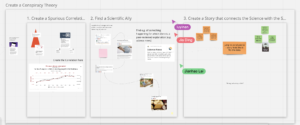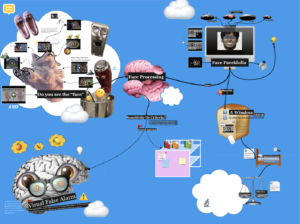

Can ordinary things become incredible? Have you carefully observed the details of life? When I came back to the topic of “weird research” again, I lay still on the grass and looked at the clouds in the sky, as if it was the first time I noticed that the clouds in the sky looked like human faces, and then around my friends did not see this phenomenon. It’s funny to me at the same time weird. In fact, many times when we look at mountains, rocks, and many things, we will see human faces. As a common form of apophenia, the human tendency to perceive meaningful patterns from random data, face pareidolia reveals a particular preference for faces when observing ambiguous stimuli in the real world. Some noted examples of face pareidolia include a face on Mars, the Virgin Mary in a piece of toast, Mother Teresa in a cinnamon bun, and the face of testicular pain. These illusory face perceptions from non-face objects or patterns, face pareidolia. A fascinating fact about facial pareidolia is that some people see it more often than others.
Therefore, I put this strange phenomenon in my daily life into my Basho for analysis and research. During the process of collecting data, I was pleasantly surprised to find that this simple and ordinary thing has a huge impact on medicine and human society. The individual differences in face pareidolia could not only offer scientific insights on how the brain works to process face information, but also suggest potential clinical applications.
However, while human brains seem to be hard-wired for face detection, the subjective face pareidolia experience varies from individual to individual. Some claim to see faces everywhere, while others find it difficult to detect faces in unusual locations. Of these four factors, I did an in-depth investigation into neurodevelopment. Going back to the question “Are Strange Things Soliciting Legitimate Research Forms or Encouraging Pseudo Research?” Many people are hesitant and worried about strange things. In this facial pareidolia research report I analyzed, I found that autism Children and adolescents with spectrum disorders (ASD) have severe deficits in recognizing faces in face-fuzzing stimuli; they not only have higher face recognition thresholds than usual development controls but also have reduced facial responses overall. Similar results were found in the Williams syndrome and Down syndrome populations. However, the causes of reduced facial pallor in autism, Williams syndrome, and Down syndrome may differ. Deficits in social interaction and communication have been described as a key symptom of autism, which may be related to their atypical face encoding process. However, individuals with Williams syndrome tend to have extra social personality traits that drive more social interactions. People with Down syndrome have delayed cognitive development but relatively strong social skills. Face pareidolia can be applied to clinical research. The Pareidolia Test has been shown to be a fast and easy-to-use application and reveals potential biomarkers for neurodegeneration in patients. Further development of face pareidolia application may facilitate diagnosis and intervention for social-related disorders, such as ASD and William syndrome. Through the investigation of facial pareidolia, I found that people are not encouraging pseudo-research on strange things. As long as the pseudo-research goes to the root, it will eventually turn into absurdity. of physical evidence. Yet legitimate forms of research can ultimately be applied to medicine and society for the benefit of society, so I think the odd thing is soliciting legitimate forms of research.
Going back to art, as students we often encounter works of art that we don’t understand, and often feel weird and boring. There are many possibilities of art, and some art even pursues people’s ignorance. Many art forms under the guidance of Japanese aesthetics are like this. In fact, understanding is not the ultimate goal of art appreciation. From an aesthetic point of view, really excellent works of art are not designed to cater to the audience’s taste, but many of them challenge the audience’s original thinking and viewpoints, stimulate the audience’s imagination, and give the audience an emotional and aesthetic impact. Seeing and understanding art appeals to reason, which is important for understanding works of art, but it is two different things from art appreciation and aesthetics. The real highlight of appreciating a work of art is to appeal to perceptual aesthetic intuition, the intuitive feeling that the moment you see the work brings you, whether it is moved, shocked, evoked emotional memories, or confused or disgusted, Fear, these are the places where works of art “live” and really “communicate” with the audience. In fact, there is no need for too many fixed explanations about a work of art. Even if it cannot be recognized and understood by most people, it does not mean that it has lost its artistic value. Nowadays, the concept of “art” in the eyes of amateurs or art practitioners often means that it is intertwined with words such as “artistic will”, “creative freedom”, “personal expression” and “breakthrough boundaries”. Art has gradually diverged from fields such as religion and politics, and so-called artistic autonomy has emerged—that is, I make a law for myself, and I don’t need other people, things, or frameworks to justify me. For example, everyone can eat and digest a baby. The value of food is not higher or lower than that of a steak that is not very convenient to eat with bad teeth, because whether it is easy to chew and digest is not directly related to the value. This is actually very similar to the content of the course of conspiracy theory. Two unrelated variables are connected to each other. Our group has also conducted investigations through the collection of some scientific news and literature, such as Meteorite crash-lands. in woman’s bed, Why do guys sleepy after sex, Man almost dies from an allergic reaction to cold air, How calories are calculated: The science behind your food and cheese fire destroys tunnel These don’t seem related but connect after creating a story the science with the spurious correlation. apophenia is what ‘feels right; it’s a desire, an ‘inner truth’ we can give permission. And high-quality fiction gives permission. Although ‘strange research’ is an academic field that does not exist and cannot exist, there is always a lot of research that seems to have nothing to do with it, but in fact, maintains an inseparable relationship with it.


I find your posts very interesting. You think about the little things and details in life, you observe the clouds in the sky, the rocks on the hills etc. These are the good things in life that we tend to overlook, but you are good at observing and applying these reflections to your artwork, really detailed observations and very interesting subject matter.
Ziqian Zhang’s blog was amazing, and for the first time I got a deep insight into how art can intervene in the human life process? How can it be used to treat illness? How can it be used to promote social development? I have benefited greatly from reading her blog.
Secondly, I think she has a very thorough understanding of contemporary art, that “looking good” is not the ultimate goal of art, and that the phrase “artistic autonomy” has opened up my mind, which I think will help me in my future studies, and I can learn a lot from her theories!
Zhiqian Zhang, this was a contemplative and engaging blog post that demonstrates a reflective engagement with your experiences during the first sprint.
You did well to provide useful analogies to aid the expression of your ideas and understanding of Weird Studies. It would’ve been good to include academic citations to accompany the resources you mentioned using, try to include this moving forwards. You also included interesting visual documentation of your basho activity but did not describe or contextualise these images within your post, try to build that link for the reader so they can see what material you produced or worked with and how that process manifested.
Really encouraging to see a deep engagement with the theme and how to apply it to your own understanding of the world, well done!